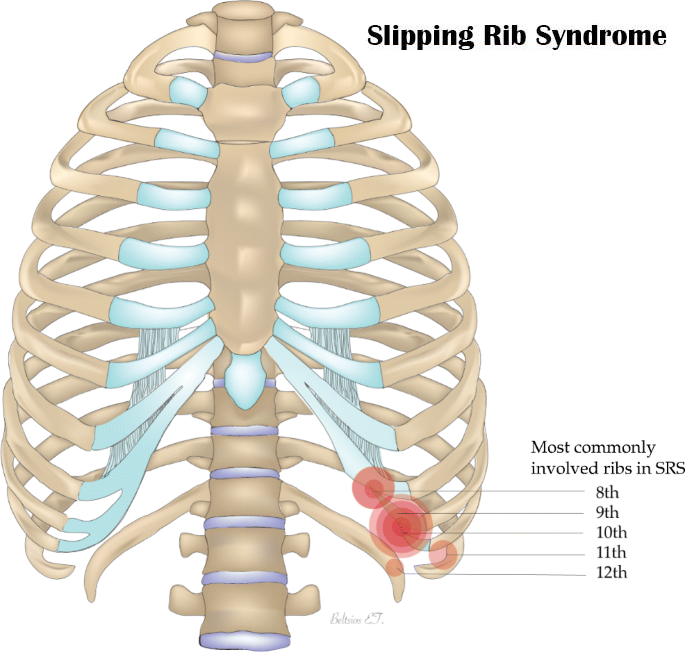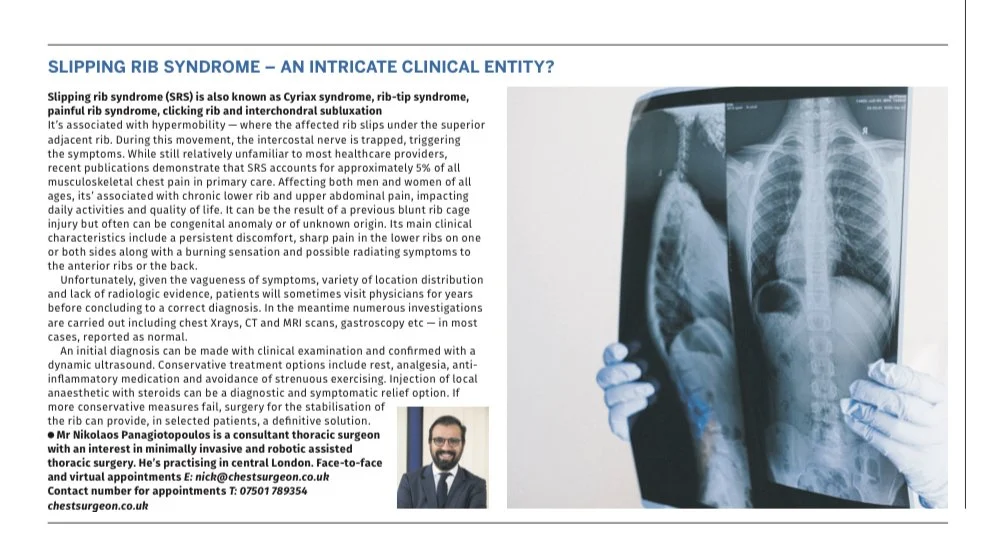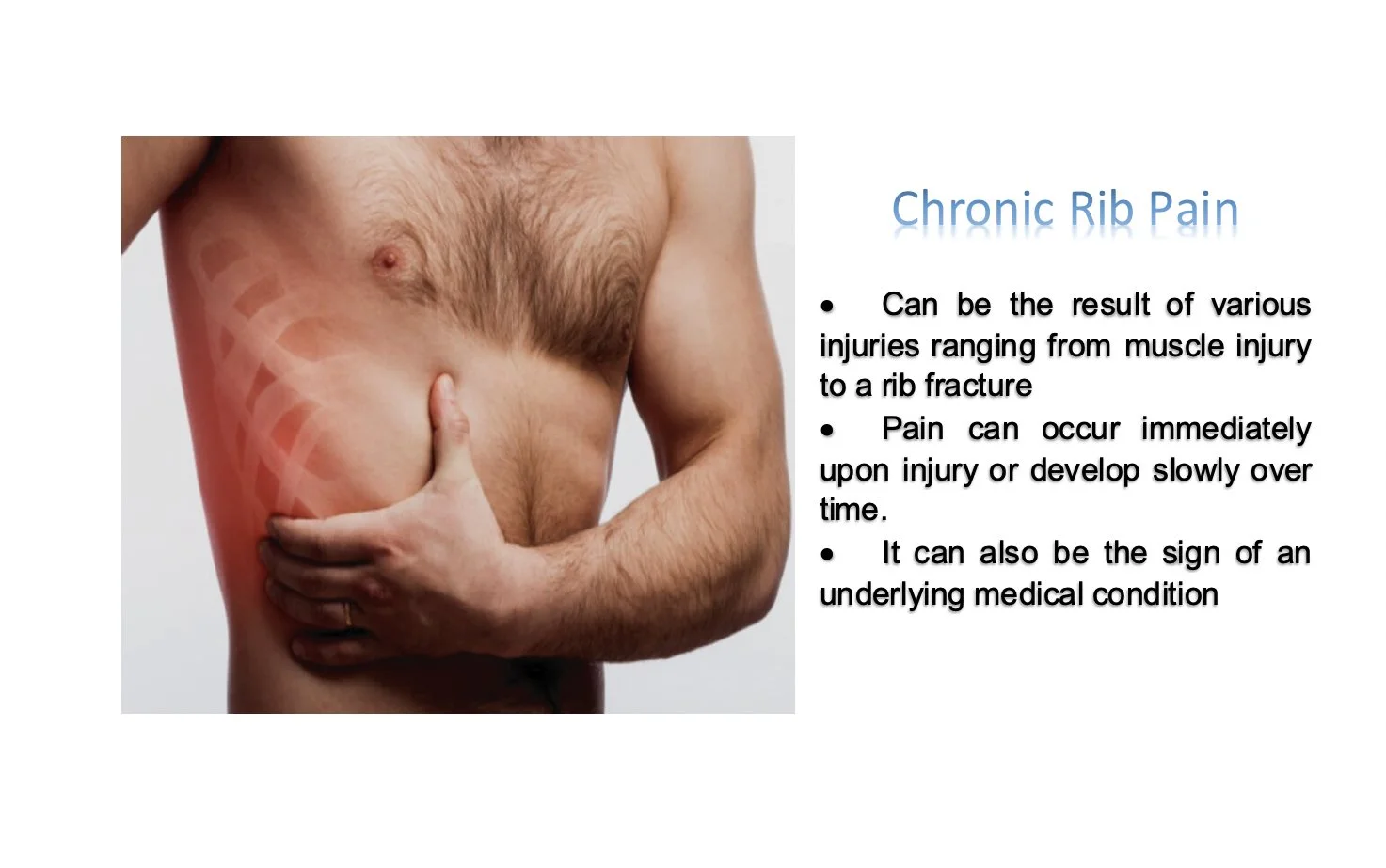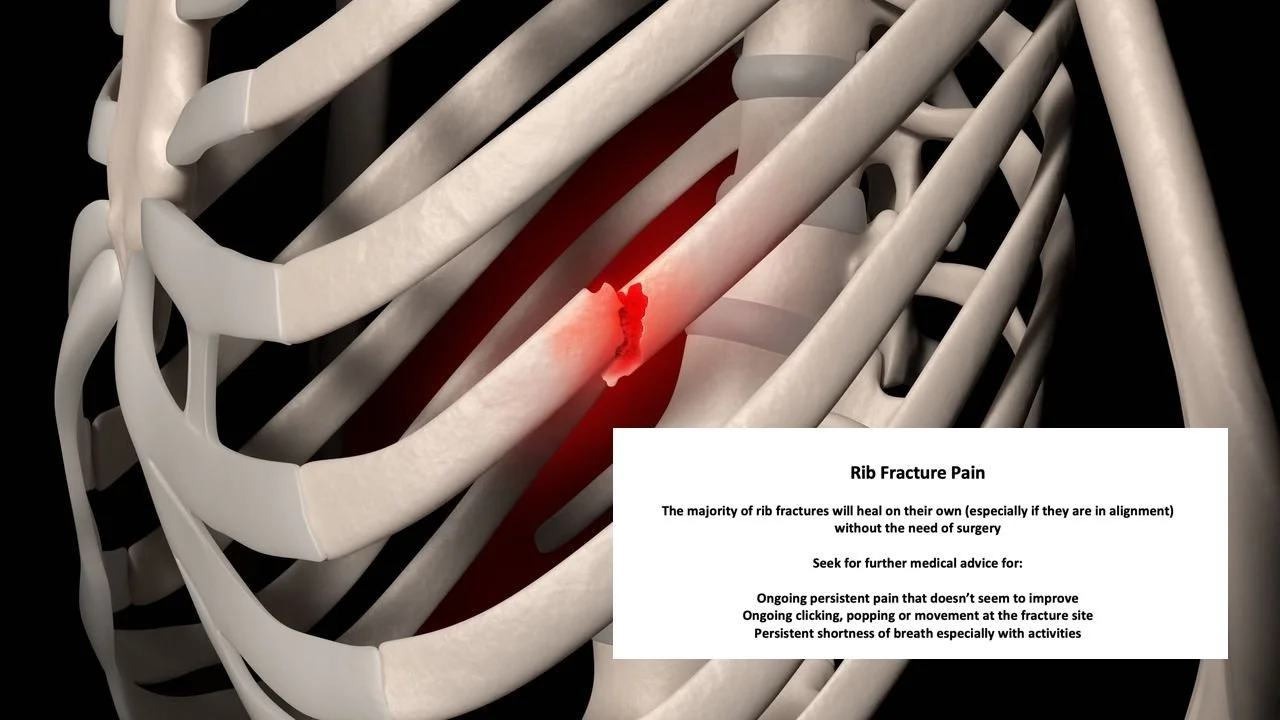Slipping Rib Syndrome and the Expertise of Mr Nikolaos Panagiotopoulos
Slipping rib syndrome (SRS) is a widely under-recognized condition in which the lower ribs—typically the 8th, 9th, or 10th—subluxate, causing sharp or aching pain in the lower chest, upper abdomen, or back. A hallmark symptom is a popping, clicking, or slipping sensation, often triggered by twisting, deep breathing, or coughing . Diagnosing SRS relies on the “hooking manoeuvre”—a physical exam that reproduces the pain—and may be confirmed with dynamic ultrasound or a diagnostic nerve block. Most cases respond well to conservative treatment such as rest, NSAIDs, physical therapy, and intercostal nerve blocks. When symptoms persist, surgical intervention—such as costal cartilage excision or rib stabilization—can be definitive.
Mr Nikolaos Panagiotopoulos, MD, PhD, FICS, FSSO is one of the world’s foremost specialists in slipping rib syndrome. He leads an internationally renowned chest-wall clinic focused on diagnosis and management of rib abnormalities, including a dedicated slipping rib programme.Trained in minimally invasive techniques, Mr Panagiotopoulos offers expert care, from thorough clinical assessment to advanced surgical solutions .
Persistent rib pain during training? A popping sensation with twisting movements? You might be dealing with Slipping Rib Syndrome (SRS) — a condition that is often overlooked, especially in athletes and active people.
🏋️ Why Athletes Are at Higher Risk
Athletes and physically active individuals frequently perform movements that involve:
Twisting, bending, or high-impact activities
Intense use of abdominal and intercostal muscles
Sudden directional changes or repetitive strain
Sports like CrossFit, gymnastics, rowing, martial arts, and even swimming may increase the likelihood of aggravating a hypermobile rib, especially in individuals with underlying anatomical predispositions.
Unfortunately, many athletes are misdiagnosed with costochondritis, muscle strain, or even psychosomatic pain, delaying proper treatment.
📅 When to Seek Help
If you’re an athlete or active individual experiencing:
Unexplained lower rib pain
Clicking or popping sensations during movement
Pain that limits performance despite rest
…it’s time to speak with a specialist. Early diagnosis and tailored treatment can get you back to full activity — without pain.
Mr Panagiotopoulos is a world-renowned thoracic surgeon with specialist expertise in slipping rib syndrome, particularly in high-performance individuals. As one of the few UK surgeons who regularly performs minimally invasive and robotic chest wall procedures, he brings unmatched precision to both diagnosis and surgical treatment.
SLIPPING RIB SYNDROME VS COSTOCHONDRITIS
Top Causes of Rib Pain Without Trauma
Experiencing rib pain without a history of trauma can be both confusing and concerning. Many patients are surprised to find that chest or rib discomfort can arise without any obvious injury. At our specialist rib pain clinic in London, we frequently evaluate patients with persistent rib or chest wall pain who have never suffered a fall or impact.
Here are some of the most common non-traumatic causes of rib pain:
1. Slipping Rib Syndrome
A frequently underdiagnosed condition, slipping rib syndrome occurs when the lower ribs become hypermobile, irritating surrounding nerves and tissues. This leads to intermittent sharp pain, often worsened by movement, bending, or deep breathing. Many patients are told for months—or years—that their pain is muscular or psychosomatic.
2. Costochondritis
This is an inflammation of the cartilage connecting the ribs to the sternum (breastbone). It can mimic heart or lung problems and typically causes tenderness and sharp pain in the upper chest wall. Costochondritis is a common cause of rib pain without trauma in younger adults and athletes.
3. Intercostal Neuralgia
Nerve irritation or compression between the ribs can result in burning, shooting, or stabbing pain along the rib cage. It may be caused by viral infections (like shingles), post-surgical changes, or unknown triggers. Diagnosis often requires careful clinical evaluation.
4. Chronic Rib Stress or Overuse
Repetitive strain, poor posture, or chronic coughing (from asthma or COPD) can cause rib stress reactions, even in the absence of acute injury. These may lead to small stress fractures or cartilage inflammation.
5. Referred Pain from the Spine or Abdomen
Rib pain can sometimes originate from the thoracic spine, or be referred from abdominal organs (e.g., gallbladder or liver conditions). A detailed history and appropriate imaging are key to identifying the true cause.
🩺 When to See a Rib Pain Specialist
If your rib pain is persistent, unexplained, or interfering with daily activities, it’s important to consult a specialist. At our London-based rib pain clinic, we offer advanced imaging—including 3D CT scans—and expert assessment to diagnose even the most elusive causes of chest wall pain.
3D Imaging for Rib Fractures: A Game-Changer in Diagnosis and Treatment
Rib fractures are a common cause of chest pain, often resulting from trauma, accidents, or repetitive strain. Unfortunately, many rib injuries are missed on standard X-rays—especially hairline or posterior fractures. This is where 3D imaging for rib fractures has revolutionised diagnosis and management.
3D CT scans offer a highly detailed, three-dimensional view of the rib cage, making it easier to detect even the most subtle rib injuries. Unlike traditional imaging, 3D reconstruction allows thoracic surgeons to visualise the exact location, angle, and severity of the rib fracture, which is critical for planning effective treatment.
Patients suffering from chronic rib pain, slipping rib syndrome, or undiagnosed chest wall injuries can particularly benefit from 3D imaging. It enables a more accurate diagnosis and can help distinguish between fractured ribs, cartilage injuries, or other causes of persistent discomfort.
At our specialist rib clinic, we routinely use advanced 3D imaging for rib injuries to ensure precise diagnosis and personalised treatment plans. Whether managing a single rib fracture or complex chest wall trauma, this technology plays a key role in guiding both conservative care and surgical intervention.
If you've been struggling with unresolved rib pain or have had a rib injury that hasn't healed properly, 3D rib cage imaging may provide the clarity needed to move forward with the right treatment.









